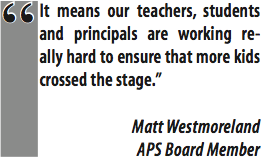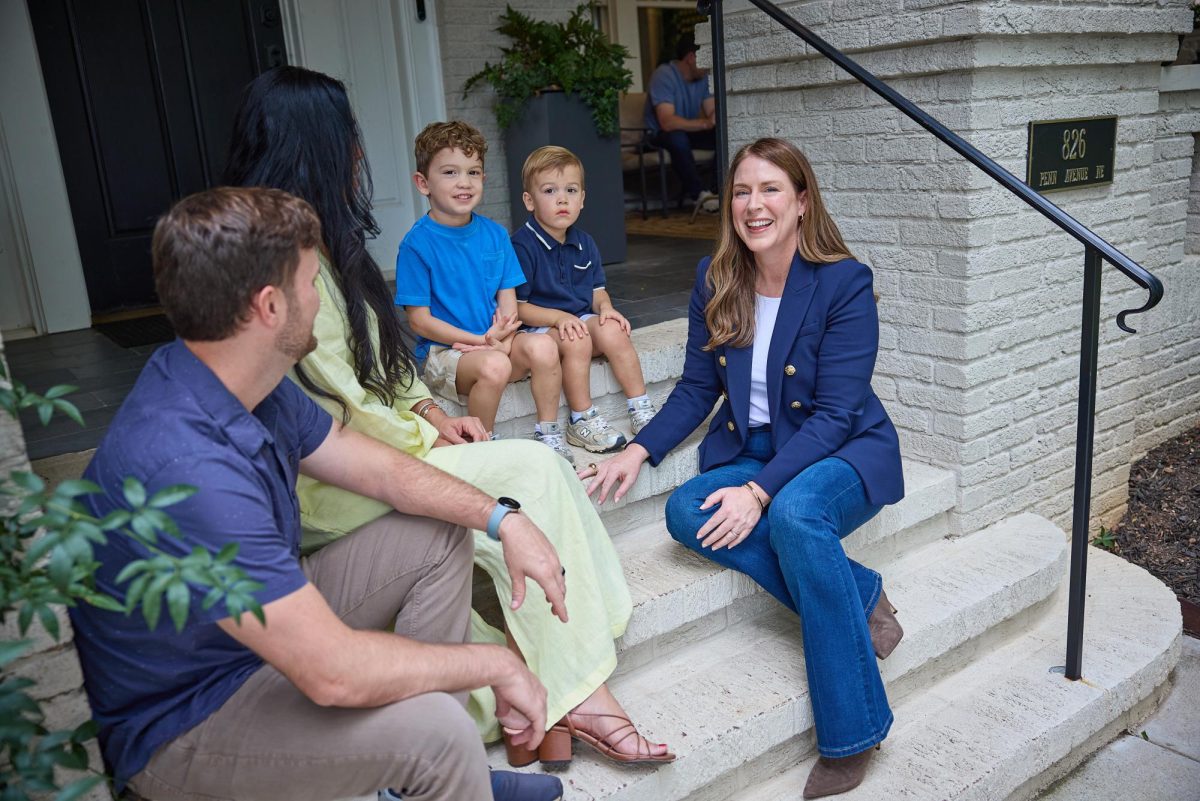The Atlanta Public Schools 2015 graduation rate rose by 12.4 percent from 2014’s rate, according to a report released by the Georgia Department of Education. Likewise, Grady experienced growth. The district aims to maintain this trend.
APS’ rate increased to 71.5 percent while the Grady graduation rate rose to 89.7 percent, a 7.3 percent increase from the previous year.
“First of all, it’s exciting,” APS Board member Matt Westmoreland said. “Going up 12 points is solid growth.”
Many factors led to the increase, including targeted district-based efforts and a change in state testing requirements.
In March 2015, the Georgia Senate officially approved House Bill 91, which eliminated the Georgia High School Graduation Test as a requirement for graduation.
“The [Georgia Graduation Test] is no longer in effect, and everybody agrees that is part of the growth,” Westmoreland said. “Our data people believe it is responsible for half of the growth. The other half is teachers and staff working really hard.”
Grady has implemented a variety of methods to raise the graduation rate. Before 2011, the Grady graduation rate had stabilized somewhere in the low 90s, with slight yearly variation. Instructional Specialist Byron Barnes explains that in 2011, the state changed school requirements for reporting the graduation rate that impacted Grady.
“Prior to 2011, in Atlanta Public Schools, students would withdraw and as long as someone communicated to us that they were transferring … we pretty much counted those students as transfers,” Barnes said. “In 2011, the state said ‘We’re no longer going to take your word for it; you have to have documentation that that student actually transferred to wherever they said that they were going.’”
Because Grady gave students everything needed to begin at a new school when they left, the administration had difficulty tracking those students down to ensure they were attending another high school. As APS and Grady have high transfer rates, this forced the graduation rate from a consistent rate in the low 90s to 73 percent in 2011. In response to this decrease, the registrar began to hold necessary materials such as transcripts from transferring students in order to begin a dialogue with the new schools. This allowed for official communication and proof of transfer. As a result, the official graduation rate has been steadily increasing since 2011.
“One of the things that has helped improve our graduation rate from 2011 to 2015 is just better documentation,” Barnes said. “Now we have records of those students transferring to another school.”
In addition to official documentation and the elimination of the GGT requirement, Grady has been implementing instructional programs to aid students in danger of not graduating. Many of these changes came in response to Grady’s “focus group designation.” Focus schools are the 10 percent of Title I schools in Georgia with the worst recorded achievement gaps over the last three years. The Georgia Department of Education provides focus schools with additional financial and educational support to implement new programs in order to close the achievement gap. Grady was taken off the state’s list last year.
“On the instructional side also, particularly with our focus group designation for the last three or four years, we have done a better job of identifying students who are in jeopardy of not graduating on time,” Barnes said. “We set up supports through SST, Special Ed, of course the counselors, graduation coaches working together to try to provide support to those who need that extra push to make sure they graduate.”
This extra push includes placing students in support classes or tutorials and attempting to address issues that lie outside of the classroom.
Barnes explained that the most important step in helping students is to identify the problems, allowing teachers to specialize their instruction and account for these issues.
Carrie Rowe teaches a math support class, which helps students attain the math skills needed to graduate by teaching basic skills students lack and encouraging practice.
“I think having them everyday helps build relationships and figure out where their weaknesses are and their strengths,” Rowe said.
Although Grady is no longer a designated focus school, the administration plans to continue with classes and programs like Rowe’s to help students.
“We are continuing to utilize some of those practices that we were implementing so we don’t fall on any other lists in the future,” Barnes said. “Just because we’re off the focus school list doesn’t mean that we’re not going to continue some of those practices.”
APS has mirrored Grady’s priorities in its spending this year.
“Sixty six percent of the [APS] budget was spent on instruction and that was the largest percent ever, or at least in the last decade,” Westmoreland said. “We spent more in student services, and we had $5 million for clusters to spend how they wanted to.”
Westmoreland believes this allocation of resources has helped increase the graduation rate, but thinks more work still lies ahead at the district level.
“Seventy one percent graduation still means 29 percent aren’t graduating and that’s still too high,” he said.
In the future, he believes the district needs to address other areas in order to best help students.
“Graduation from high school is only part of it,” Westmoreland said. “The diploma has to mean something. We have a lot more work to do to make sure kids are ready for college and careers.”
He still sees this year’s growth as an encouraging testament to the district’s progress.
“It means our teachers, students and principals are working really hard to ensure that more kids crossed the stage and that happened,” Westmoreland said.
Although aspects of the class frustrate Rowe, she sees the effect of her support class.
“I think it’s definitely helping,” Rowe said. “I felt confident going into the EOCT last year.”
While the Grady graduation rate has seen consistent growth in the last four years, teachers and administrators believe more can be done.
“Students should know that we are here to help them,” Barnes said. “There is so much that is available if they would just reach out … before committing to dropping out. Ask for help if you feel overwhelmed. If you don’t want to finish school, ask for help, and we can see what we can do for you.”







